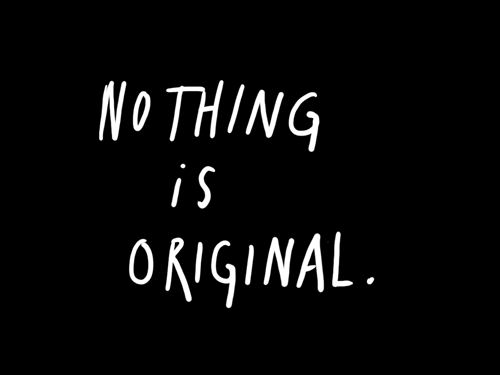
cc licensed ( BY NC ) flickr photo shared by ryancr
We learn early and repeatedly that stealing is bad (and it is if we are talking about malicious theft), but perhaps as we grow older? wiser? that there are layers to this concept, and I am just loving How to Steal Like an Artist (and 9 other things nobody told me) by Austin Kleon. A big kudos to Andy Rush for tweeting this link.
There are powerful ideas here. Sometimes you come across a link and maybe toss it in the social bookmarking pile, sometimes it is better and worth sharing via a tweet, and then there are ones I find I just have to blog up and down about. Maybe this resonates in relation to what has been flowing by the last months in ds106, but I find more here, that not only apply more broadly in education, but really tap into my core beliefs.
So I could provide a detailed review here, but go read the damned thing yourself, then come back.

cc licensed ( BY ) flickr photo shared by Don Hankins
Okay, there is a lot of truth to the opening statement
All advice is autobiographical.
It’s one of my theories that when people give you advice, they’re really just talking to themselves in the past.
It’s pretty obvious, we live inside these containers of self, so of course it is our prime reference point. But its worth remembering that when you get advice, it is really coming out of someone else’s own experience. My own corollary would be:
Always keep in mind everyone’s favorite subject.
That would be themselves. You can be known as a brilliant conversationalist if you let people go on and on about their favorite subject. There is a range of degrees to this, but now I am tangenting myself elsewhere.
Back to Stealing like an Artist, which is the first item on the list.
It came up in ds106 last week with reading some student’s comments on the readings related to remix and mashups. There was more than a few assertions that these were not “Art” (capitalized ans care quotes added by moi) because they are not original.
I’ve not gone to art school or even taken courses, but this seems to be something they cram into new students- that only Art is original. And if it’s not so original, it’s not Art?
It’s not that there is not originality in Art, but that all forms of expression are influenced by what has come before. What Austin suggests is that we immerse ourselves to be exposed to ideas, influences, etc- to be a “collector”:
You are, in fact, a mashup of what you choose to let into your life. You are the sum of your influences. The German writer Goethe said, “We are shaped and fashioned by what we love.”
…
Your job is to collect ideas. The best way to collect ideas is to read. Read, read, read, read, read. Read the newspaper. Read the weather. Read the signs on the road. Read the faces of strangers. The more you read, the more you can choose to be influenced by.
Down the page he gets to some more powerful ideas, like “Don’t wait until you know who you are to start making things.” This was part of what we hoped would happen in ds106 to have a constant flow of ways to be creative- like I am passionate about doing my daily photography, we all ought to be creating things on a daily basis… little things, experimental things, but it is like exercise- you want to flex those creativity centers as much as you can.
And this leads into the things that we need to get over, like “I’m not creative..” or “I’m not good at X” — the good ole Imposter Syndrome— (I bear my own guilt in lapsing here– or how it is slyly put:
Fake it til you make it
There’s two ways to read it: Fake it “˜til you make it, as in, fake it until you’re successful, until everybody sees you the way you want, etc. Or, fake it til’ you make it, as in, pretend to be making something until you actually make something.
I also like the emphasis on “Side projects and hobbies are important”– that it is sometimes in the act of doing something out of your primary job or focus area, that maybe the brain relaxes or bubbles, and something un-expected emerges. It’s when you really put aside your own self critical layers, and just do “what if…” type thinking. We too easily make our own silos and blinders of “what our job is”.
And this leads me to the one that got me jumping up and down saying BOOYAH–
This has been my modus operandi since I first plugged that Mac Quadra into the internet in the early 1990s. You go a lot farther in your efforts when you put it “out there” and make it available to others. It’s the stuff I still find amazing.
This is so beautiful:
I tell people this, and then they ask me, “What’s the secret of the internet?”
Step 1: Wonder at something. Step 2: Invite others to wonder with you.
You should wonder at the things nobody else is wondering about. If everybody’s wondering about apples, go wonder about oranges.
Inviting others to wonder with you can be as simple as a tweet but can go a lot bigger. Let yourself be open to the serendipity (reading blogs out of your field, follow links to new sources). The internet is not truly infinite, but on a human scale it can come pretty darn close, so dont focus all your time looking at the sites and sources that everyone else in your field eyeballs.
It’s why I keep a folder of feeds in my Google Reader called “Odds and Ends”- its usually just weird stuff, but I rarely fail to find something that goes a notch up from that.
And in the painfully obvious department, yet we lose site of–
8. Be nice. The world is a small town.
The best way to vanquish your enemies on the internet? Ignore them.The best way to make friends on the internet? Say nice things about them.
This is not to say be fake nice and smarmy, but play out that golden rule– its gold for a good reason.
I love this post, and am going to fall back on it again again.
So tomorrow, think about stealing like an artist. And the day after that. And the…..

cc licensed ( BY ) flickr photo shared by tibchris





CogDogBlogged: Stealing Stealing http://bit.ly/faGdi1
This comment was originally posted on Twitter
New Post: Stealing Stealing: cc licensed ( BY NC ) flickr photo shared by ryancr We learn early and r… http://bit.ly/fyKMRt by @cogdog
This comment was originally posted on Twitter
Stealing Stealing – CogDogBlog http://t.co/su60oX7 via @cogdog
This comment was originally posted on Twitter
Stealing Stealing – CogDogBlog http://t.co/L1tM3lM via @cogdog
This comment was originally posted on Twitter
Good post by @cogdog – http://bit.ly/fDyvzY – particularly like “Step 1: Wonder at something. Step 2: Invite others to wonder with you”
This comment was originally posted on Twitter
Stealing, stealing http://bit.ly/fDyvzY
This comment was originally posted on Twitter
Stealing, stealing http://bit.ly/fDyvzY
This comment was originally posted on Twitter